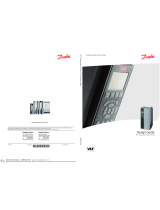
Liquids can be carried through the air and condense in the
adjustable frequency drive and may cause corrosion of
components and metal parts. Steam, oil, and salt water
may cause corrosion of components and metal parts. In
such environments, use equipment with enclosure rating IP
54/55. As an extra protection, coated printed circuit boards
can be ordered as an option.
Airborne particles such as dust may cause mechanical,
electrical or thermal failure in the adjustable frequency
drive. A typical indicator of excessive levels of airborne
particles is the presence of dust particles around the
adjustable frequency drive fan. In very dusty environments,
use equipment with enclosure rating IP 54/55 or a cabinet
for IP 00/IP 20/TYPE 1 equipment.
In environments with high temperatures and humidity,
corrosive gases such as sulfur, nitrogen, and chlorine
compounds cause chemical processes on the adjustable
frequency drive components.
Such chemical reactions rapidly affect and damage the
electronic components. In such environments, mount the
equipment in a cabinet with fresh air ventilation, keeping
aggressive gases away from the adjustable frequency drive.
An extra protection in such areas is a coating of the
printed circuit boards, which can be ordered as an option.
NOTICE!
Mounting adjustable frequency drives in aggressive
environments increases the risk of stoppages and consid-
erably reduces the life of the adjustable frequency drive.
Before installing the adjustable frequency drive, check the
ambient air for liquids, particles and gases. This is done by
observing existing installations in this environment. Typical
indicators of harmful airborne liquids are water or oil on
metal parts, or corrosion of metal parts.
Excessive dust particle levels are often found on instal-
lation cabinets and existing electrical installations. One
indicator of aggressive airborne gases is the blackening of
copper rails and cable ends on existing installations.
D and E enclosure types have a stainless steel backchannel
option to provide additional protection in aggressive
environments. Proper ventilation is still required for the
internal components of the adjustable frequency drive.
Contact Danfoss for additional information.
2.5
Vibration and Shock
The adjustable frequency drive has been tested according
to the procedure based on the shown standards:
•
IEC/EN 60068-2-6: Vibration (sinusoidal) - 1970
•
IEC/EN 60068-2-64: Vibration, broad-band random
The adjustable frequency drive complies with requirements
that exist for units mounted on the walls and floors of
production premises, as well as in panels bolted to walls or
floors.
2.6 Safe Torque Off
The FC 102 can perform the safety function Safe Torque Off
(STO, as defined by EN IEC 61800-5-2
1
) and Stop Category 0
(as defined in EN 60204-1
2
).
Before integrating and using Safe Torque Off in an instal-
lation, a thorough risk analysis on the installation must be
carried out in order to determine whether the Safe Torque
Off functionality and safety levels are appropriate and
sufficient. It is designed and approved as suitable for the
requirements of:
•
Category 3 in EN ISO 13849-1
•
Performance Level "d" in EN ISO 13849-1:2008
•
SIL 2 Capability in IEC 61508 and EN 61800-5-2
•
SILCL 2 in EN 62061
1) Refer to EN IEC 61800-5-2 for details of Safe torque off
(STO) function.
2) Refer to EN IEC 60204-1 for details of stop category 0
and 1.
Activation and Termination of Safe Torque Off
The Safe Torque Off (STO) function is activated by
removing the voltage at Terminal 37 of the Safe Inverter.
By connecting the Safe Inverter to external safety devices
providing a safe delay, an installation for a Safe Torque Off
Category 1 can be obtained. The Safe Torque Off function
of FC 102 can be used for asynchronous, synchronous
motors and permanent magnet motors. See examples in
chapter 2.6.1 Terminal 37 Safe Torque Off Function.
WARNING
After installation of Safe Torque Off (STO), a commis-
sioning test as specified in section Safe Torque Off
Commissioning Test must be performed. A passed
commissioning test is mandatory after first installation
and after each change to the safety installation.
Introduction to VLT® HVAC D... Design Guide
MG11BC22 Danfoss A/S © Rev. 06/2014 All rights reserved. 15
2 2





















